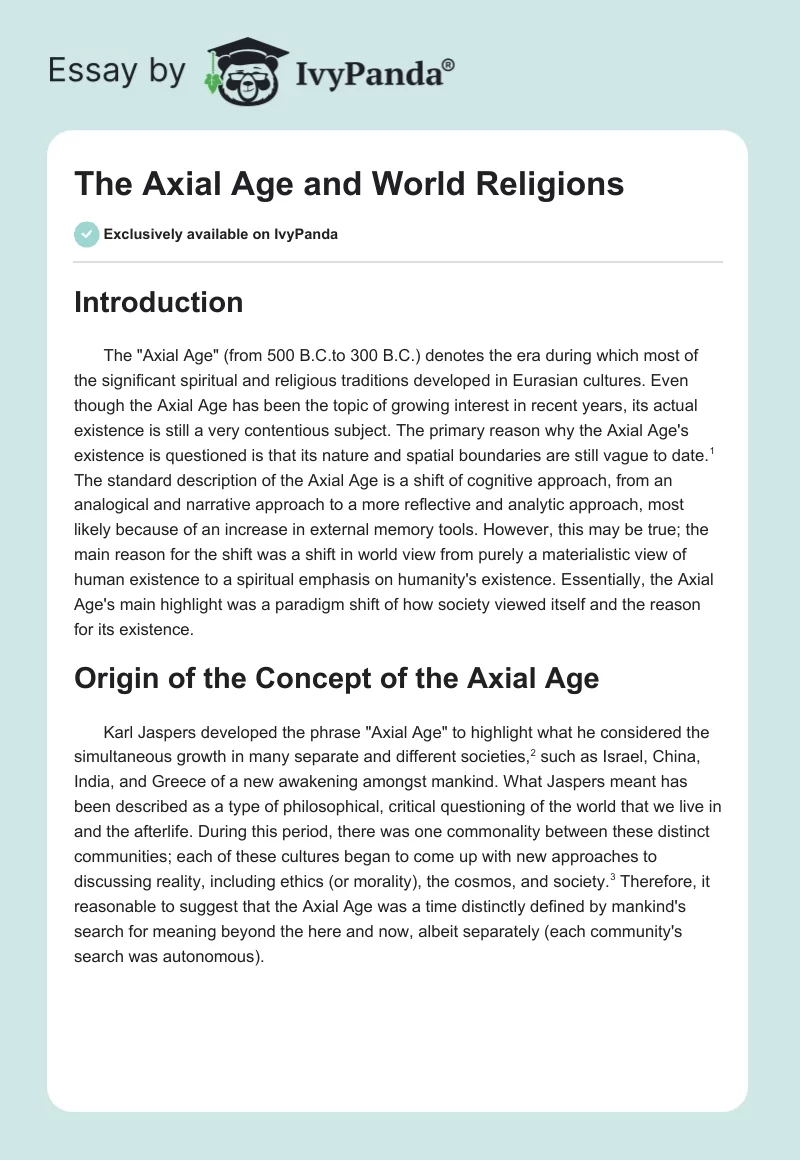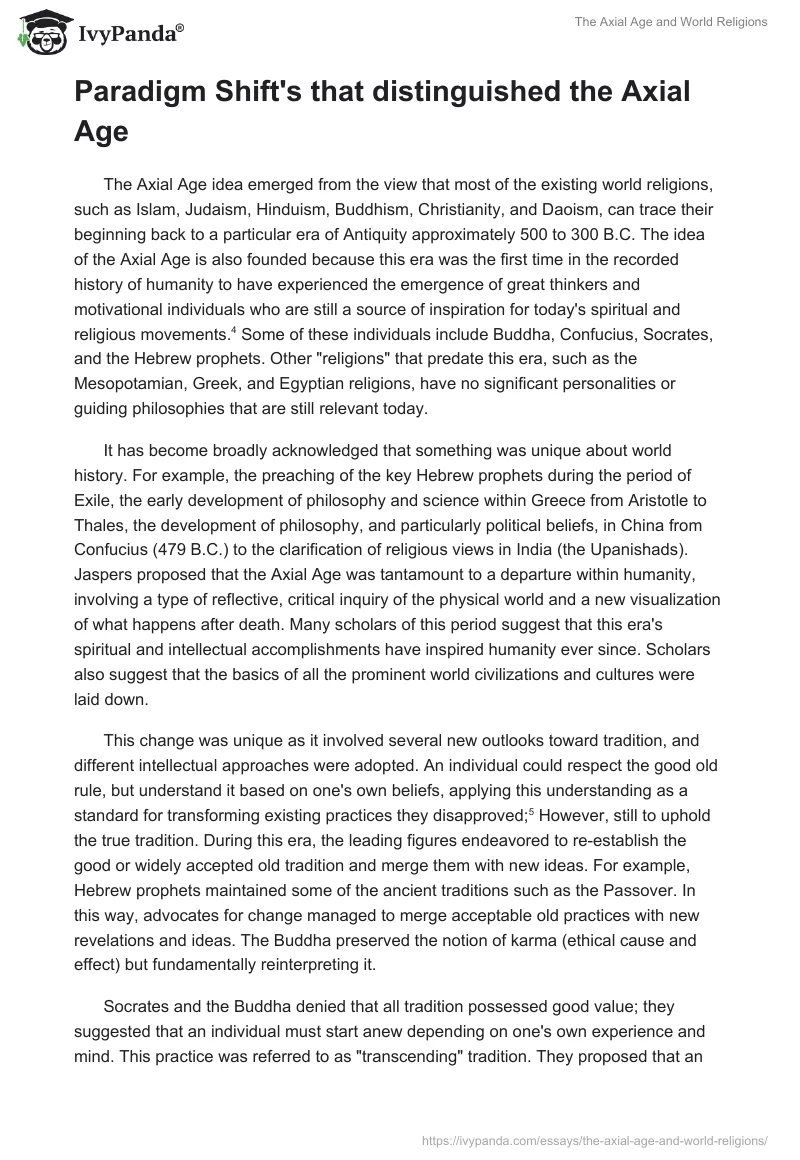Introduction
The “Axial Age” (from 500 B.C.to 300 B.C.) denotes the era during which most of the significant spiritual and religious traditions developed in Eurasian cultures. Even though the Axial Age has been the topic of growing interest in recent years, its actual existence is still a very contentious subject. The primary reason why the Axial Age’s existence is questioned is that its nature and spatial boundaries are still vague to date. The standard description of the Axial Age is a shift of cognitive approach, from an analogical and narrative approach to a more reflective and analytic approach, most likely because of an increase in external memory tools.
However, this may be true; the main reason for the shift was a shift in world view from purely a materialistic view of human existence to a spiritual emphasis on humanity’s existence. Essentially, the Axial Age’s main highlight was a paradigm shift of how society viewed itself and the reason for its existence.
Origin of the Concept of the Axial Age
Karl Jaspers developed the phrase “Axial Age” to highlight what he considered the simultaneous growth in many separate and different societies, such as Israel, China, India, and Greece of a new awakening amongst mankind. What Jaspers meant has been described as a type of philosophical, critical questioning of the world that we live in and the afterlife.
During this period, there was one commonality between these distinct communities; each of these cultures began to come up with new approaches to discussing reality, including ethics (or morality), the cosmos, and society. Therefore, it reasonable to suggest that the Axial Age was a time distinctly defined by mankind’s search for meaning beyond the here and now, albeit separately (each community’s search was autonomous).
Paradigm Shift’s that distinguished the Axial Age
The Axial Age idea emerged from the view that most of the existing world religions, such as Islam, Judaism, Hinduism, Buddhism, Christianity, and Daoism, can trace their beginning back to a particular era of Antiquity approximately 500 to 300 B.C. The idea of the Axial Age is also founded because this era was the first time in the recorded history of humanity to have experienced the emergence of great thinkers and motivational individuals who are still a source of inspiration for today’s spiritual and religious movements. Some of these individuals include Buddha, Confucius, Socrates, and the Hebrew prophets. Other “religions” that predate this era, such as the Mesopotamian, Greek, and Egyptian religions, have no significant personalities or guiding philosophies that are still relevant today.
It has become broadly acknowledged that something was unique about world history. For example, the preaching of the key Hebrew prophets during the period of Exile, the early development of philosophy and science within Greece from Aristotle to Thales, the development of philosophy, and particularly political beliefs, in China from Confucius (479 B.C.) to the clarification of religious views in India (the Upanishads). Jaspers proposed that the Axial Age was tantamount to a departure within humanity, involving a type of reflective, critical inquiry of the physical world and a new visualization of what happens after death. Many scholars of this period suggest that this era’s spiritual and intellectual accomplishments have inspired humanity ever since. Scholars also suggest that the basics of all the prominent world civilizations and cultures were laid down.
This change was unique as it involved several new outlooks toward tradition, and different intellectual approaches were adopted. An individual could respect the good old rule, but understand it based on one’s own beliefs, applying this understanding as a standard for transforming existing practices they disapproved; However, still to uphold the true tradition. During this era, the leading figures endeavored to re-establish the good or widely accepted old tradition and merge them with new ideas. For example, Hebrew prophets maintained some of the ancient traditions such as the Passover. In this way, advocates for change managed to merge acceptable old practices with new revelations and ideas. The Buddha preserved the notion of karma (ethical cause and effect) but fundamentally reinterpreting it.
Socrates and the Buddha denied that all tradition possessed good value; they suggested that an individual must start anew depending on one’s own experience and mind. This practice was referred to as “transcending” tradition. They proposed that an individual could subject everything to analysis and assume nothing, understanding both what exists and human potential without considering what other people had said in the past. Essentially, during the Axial Age, all principles and beliefs were open to discussion. This perspective was adopted by some Greeks, particularly Socrates and the Sophists. They made intellectual openness and inquiry into the principle and actual aim of thought and public discourse.
During the Axial Age, critical science inquiry-philosophy played an essential role in China and Greece’s religious breakthrough. In both cases, there was a continuous debate about philosophical, social, and ethical issues. In India, the spiritual inquiry was practiced as a type of personal search through self-denial and meditation, which formed Buddhism as well as other spiritual movements. The genre of arthashastra (politics and economics) applied philosophy through systematic inquiry based on practical evidence. Israel also had a plurality of ways, including prophetic and Levitical. Therefore, in each case, there was intra-cultural dialogue during the Axial Age.
In China, India, and Greece, alternative beliefs emerged from what had previously been a single cultural and spiritual unit. In Israel, discourse about spirituality was more restricted to what was written in revealed texts. During this era, the entire intellectual shift was more open, more inquiring, and offered more choices of psychological approaches than any other period before the Axial Age. As cultures and religions, the ideas proposed during that period became more diverse.
Discussion
Awareness about major world religions and their history is necessary for living in and understanding the world’s diversity. Both civilizations and individuals’ behavior and thinking are usually formed by religious values and beliefs, creating what may be referred to as a worldview. Information about the Axial Age helps to understand today’s religious pluralism, and current events offer plenty of proof that religion is a powerful motivating force and an essential cultural value. Undoubtedly, beliefs formed during that era have inspired several of the world’s music, beautiful art, literature, and architecture.
Religion, from the Paleolithic to Neolithic age and from the Axial Age to present-day religious practice, has been a critical principle of human societies. Therefore, appreciating the Axial Age for the immense influence it has had on today’s religion and culture is useful.
Often, world historians have highlighted other aspects of world history, like technology and trade. Still, religion should also be considered necessary because of the influence it has had in shaping societies over the years. If history involves the study of continuity and change of ecological systems and human societies over time, religion developed during the Axial Age has helped sustain and preserve the unity of communities, offer a sense of social development, maintain relationships between civilizations, transform cultures, induce change, and regenerate and renew insights into the supernatural, natural, and human worlds.
Conclusion
The Axial Age has come to be considered the largest single turning point in global history so far as the mind’s matters are concerned. Arguably, most of humanity’s subsequent developments in the religious and mental sphere emanate from critical figures during his period.
Applying this argument to the world history of religious thought, one would propose that thinkers like Confucius, Plato, and Isaiah introduced new ideas that formed the terrain following spiritual principles and values. They also played a vital role in the emergence and development of “moralistic” religious traditions. Most of these traditions developed during the Axial Age are described as those that stress adherence to pro-social customs under the threat of retribution by knowledgeable deities concerned with how humans treat each other.
References
Black, Antony. The “Axial Period”: What Was It and What Does It Signify? The Review of Politics vol. 70, 2008, pp. 23-39.
Purzycki, G. B., Ross, T. C., & and Apicella, C. Material Security, Life History, and Moralistic Religions: A cross-cultural examination. PLoS ONE, vol. 13 no. 3, 2018, pp. 1- 14.
Schwadel, Philip. Explaining Cross-National Variation in the Effect of Higher Education on Religiosity. Journal for the Scientific Study of Religion. Vol. 54 no. 2, 2015, pp. 402–418.
Turchin, Peter. Ultra-society: How 10,000 Years of War Made Humans the Greatest Cooperators on Earth. Berets Books. 2015. Print.
Unger, Roberto. The Future of Religion. Cambridge, MA: Harvard University Press, 2014. Print.


